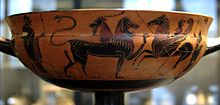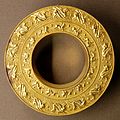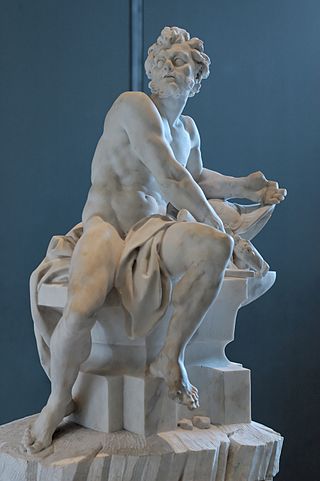
Hephaestus is the Greek god of artisans, blacksmiths, carpenters, craftsmen, fire, metallurgy, metalworking, sculpture and volcanoes. Hephaestus's Roman counterpart is Vulcan. In Greek mythology, Hephaestus was either the son of Zeus and Hera or he was Hera's parthenogenous child. He was cast off Mount Olympus by his mother Hera because of his lameness, the result of a congenital impairment; or in another account, by Zeus for protecting Hera from his advances.
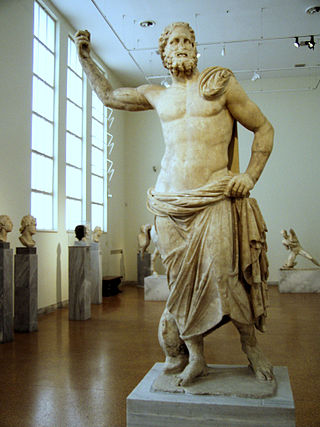
Poseidon is one of the Twelve Olympians in ancient Greek religion and mythology, presiding over the sea, storms, earthquakes and horses. He was the protector of seafarers and the guardian of many Hellenic cities and colonies. In pre-Olympian Bronze Age Greece, Poseidon was venerated as a chief deity at Pylos and Thebes, with the cult title "earth shaker"; in the myths of isolated Arcadia, he is related to Demeter and Persephone and was venerated as a horse, and as a god of the waters. Poseidon maintained both associations among most Greeks: he was regarded as the tamer or father of horses, who, with a strike of his trident, created springs. His Roman equivalent is Neptune.

The Theogony is a poem by Hesiod describing the origins and genealogies of the Greek gods, composed c. 730–700 BC. It is written in the Epic dialect of Ancient Greek and contains 1022 lines. It is one of the most important sources for the understanding of early Greek cosmology.

Zeus is the sky and thunder god in ancient Greek religion and mythology, who rules as king of the gods on Mount Olympus. His name is cognate with the first syllable of his Roman equivalent Jupiter.

Metis, in ancient Greek religion and mythology, was one of the Oceanids. She is notable for being the first wife and advisor of Zeus, the King of the Gods. She helped him to free his siblings from their father Cronus' stomach by giving him an emetic and, when she was swallowed by Zeus after it was foretold that she would bear a son mightier than his father, helped their daughter Athena to escape from his forehead.
In Greek mythology, Iobates or Jobates was a Lycian king, the father of Antea and Philonoe. He was sometimes named Amphianax.

In Greek mythology, Chrysaor was the brother of the winged horse Pegasus, often depicted as a young man, the son of Poseidon and Medusa, born when Perseus decapitated the Gorgon Medusa.
And when Perseus cut off her head, there sprang forth great Chrysaor and the horse Pegasus who is so called because he was born near the springs of Ocean; and that other, because he held a golden blade in his hands.

The Gorgons, in Greek mythology, are three monstrous sisters, Stheno, Euryale, and Medusa, said to be the daughters of Phorcys and Ceto. They lived near their sisters the Graeae, and were able to turn anyone who looked at them to stone. Euryale and Stheno were immortal, but Medusa was not and was slain by the hero Perseus.

According to Greek mythology, the Chimera, Chimaera, Chimæra, or Khimaira was a monstrous fire-breathing hybrid creature from Lycia, Asia Minor, composed of different animal parts. Typically, it is depicted as a lion with a goat's head protruding from its back and a tail ending with a snake's head. Some representations also include dragon's wings. It was an offspring of Typhon and Echidna and a sibling of monsters like Cerberus and the Lernaean Hydra.

In Greek mythology, Perseus is the legendary founder of the Perseid dynasty. He was, alongside Cadmus and Bellerophon, the greatest Greek hero and slayer of monsters before the days of Heracles. He beheaded the Gorgon Medusa for Polydectes and saved Andromeda from the sea monster Cetus. He was the son of Zeus and the mortal Danaë, as well as the half-brother and great-grandfather of Heracles.
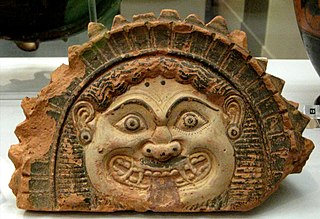
In Greek mythology, Medusa, also called Gorgo or the Gorgon, was one of the three Gorgons. Medusa is generally described as a woman with living snakes in place of hair; her appearance was so hideous that anyone who looked upon her was turned to stone. Medusa and her Gorgon sisters Euryale and Stheno were usually described as daughters of Phorcys and Ceto; of the three, only Medusa was mortal.

In ancient Greek religion and mythology, the twelve Olympians are the major deities of the Greek pantheon, commonly considered to be Zeus, Poseidon, Hera, Demeter, Aphrodite, Athena, Artemis, Apollo, Ares, Hephaestus, Hermes, and either Hestia or Dionysus. They were called Olympians because, according to tradition, they resided on Mount Olympus.
The gadfly, a type of fly, known for plaguing cattle, appears in Greek mythology as a tormenter of Pegasus and Io, a human lover of Zeus.
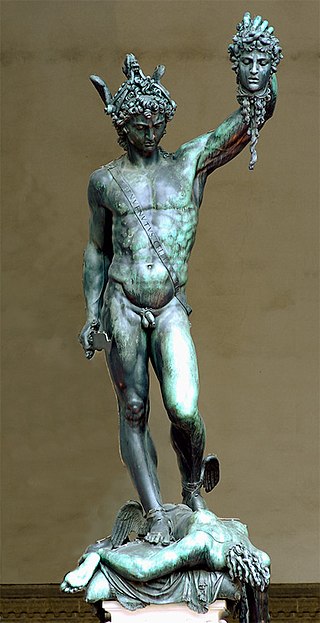
In classical mythology, the Cap of Invisibility is a helmet or cap that can turn the wearer invisible, also known as the Cap of Hades or Helm of Hades. Wearers of the cap in Greek myths include Athena, the goddess of wisdom, the messenger god Hermes, and the hero Perseus. Those wearing the Cap become invisible to other supernatural entities, akin to a cloud of mist sometimes used to remain undetectable.
Mythic Warriors is a 1998–2000 anthology animated television series, which featured retellings of popular Greek myths that were altered so as to be appropriate for younger audiences, produced by Nelvana and Marathon Media. Two seasons of episodes were produced in February 8, 1998 and March 14, 1999; then aired as reruns until May 21, 2000, when CBS' abolition of its Nelvana-produced children's programming in favor of Nick Jr. and later, Nickelodeon content resulted in its cancellation. The series was based on the book series Myth Men Guardians of the Legend written in 1996 and 1997 by Laura Geringer and illustrated by Peter Bollinger.
In Greek and Roman mythology, Glaucus, usually surnamed as Potnieus, was a son of Sisyphus whose main myth involved his violent death as the result of his horsemanship. He was the king of the Boeotian city of Potniae or sometimes of Corinth. Glaucus was the subject of a lost tragedy by Aeschylus, Glaucus Potnieus(Glaucus at Potniae), fragments of which are contained in an Oxyrhynchus Papyrus.

Bellerophon or Bellerophontes or Hipponous, was a divine Corinthian hero of Greek mythology, the son of Poseidon and Eurynome, and the foster son of Glaukos. He was "the greatest hero and slayer of monsters, alongside Cadmus and Perseus, before the days of Heracles". Among his greatest feats was killing the Chimera of the Iliad, a monster that Homer depicted with a lion's head, a goat's body, and a serpent's tail: "her breath came out in terrible blasts of burning flame."

The winged, divine horse Pegasus has been a prominent figure in modern popular culture.
Pegasides were nymphs of Greek mythology connected with wells and springs, specifically those that the mythical horse Pegasus created by striking the ground with his hooves.
In Greek mythology, Eurynome or Eurymede was a Megarian princess who became a queen of Corinth.





